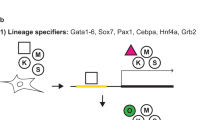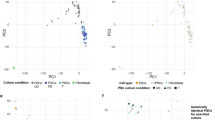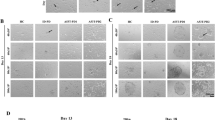Abstract
The ectopic expression of several transcription factors can restore embryonic cell fate to cultured somatic cells and generate induced pluripotent stem cells (iPSCs), revealing a previously unknown pathway to pluripotency. However, this technology is currently limited by low efficiency, slow kinetics and multi-factorial requirement. Here we show that reprogramming can be improved and dramatically accelerated by optimizing culture conditions. First, we developed an optimized defined medium, iCD1, which allows Oct4/Sox2/Klf4 (OSK)-mediated reprogramming to achieve ultra-high efficiency (∼10% at day 8). We also found that this optimized condition renders both Sox2 and Klf4 dispensable, although the elimination of these two factors leads to lower efficiency and slower kinetics. Our studies define a shortened route, both in timing and factor requirement, toward pluripotency. This new paradigm not only provides a rationale to further improve iPSC generation but also simplifies the conceptual understanding of reprogramming by defined factors.
Similar content being viewed by others
Log in or create a free account to read this content
Gain free access to this article, as well as selected content from this journal and more on nature.com
or
References
Evans MJ, Kaufman MH . Establishment in culture of pluripotential cells from mouse embryos. Nature 1981; 292:154–156.
Martin GR . Isolation of a pluripotent cell line from early mouse embryos cultured in medium conditioned by teratocarcinoma stem cells. Proc Natl Acad Sci USA 1981; 78:7634–7638.
Thomson JA, Itskovitz-Eldor J, Shapiro SS, et al. Embryonic stem cell lines derived from human blastocysts. Science 1998; 282:1145–1147.
Takahashi K, Yamanaka S . Induction of pluripotent stem cells from mouse embryonic and adult fibroblast cultures by defined factors. Cell 2006; 126:663–676.
Takahashi K, Tanabe K, Ohnuki M, et al. Induction of pluripotent stem cells from adult human fibroblasts by defined factors. Cell 2007; 131:861–872.
Yu J, Vodyanik MA, Smuga-Otto K, et al. Induced pluripotent stem cell lines derived from human somatic cells. Science 2007; 318:1917–1920.
Jaenisch R, Young R . Stem cells, the molecular circuitry of pluripotency and nuclear reprogramming. Cell 2008; 132:567–582.
Scholer HR, Hatzopoulos AK, Balling R, Suzuki N, Gruss P . A family of octamer-specific proteins present during mouse embryogenesis: evidence for germline-specific expression of an Oct factor. EMBO J 1989; 8:2543–2550.
Nichols J, Zevnik B, Anastassiadis K, et al. Formation of pluripotent stem cells in the mammalian embryo depends on the POU transcription factor Oct4. Cell 1998; 95:379–391.
Niwa H, Miyazaki J, Smith AG . Quantitative expression of Oct-3/4 defines differentiation, dedifferentiation or self-renewal of ES cells. Nat Genet 2000; 24:372–376.
Loh YH, Wu Q, Chew JL, et al. The Oct4 and Nanog transcription network regulates pluripotency in mouse embryonic stem cells. Nat Genet 2006; 38:431–440.
Wang J, Rao S, Chu J, et al. A protein interaction network for pluripotency of embryonic stem cells. Nature 2006; 444:364–368.
Chen X, Xu H, Yuan P, et al. Integration of external signaling pathways with the core transcriptional network in embryonic stem cells. Cell 2008; 133:1106–1117.
Kim J, Chu J, Shen X, Wang J, Orkin SH . An extended transcriptional network for pluripotency of embryonic stem cells. Cell 2008; 132:1049–1061.
Avilion AA, Nicolis SK, Pevny LH, Perez L, Vivian N, Lovell-Badge R . Multipotent cell lineages in early mouse development depend on SOX2 function. Genes Dev 2003; 17:126–140.
Mitsui K, Tokuzawa Y, Itoh H, et al. The homeoprotein Nanog is required for maintenance of pluripotency in mouse epiblast and ES cells. Cell 2003; 113:631–642.
Smith AG, Heath JK, Donaldson DD, et al. Inhibition of pluripotential embryonic stem cell differentiation by purified polypeptides. Nature 1988; 336:688–690.
Ying QL, Nichols J, Chambers I, Smith A . BMP induction of Id proteins suppresses differentiation and sustains embryonic stem cell self-renewal in collaboration with STAT3. Cell 2003; 115:281–292.
Ying QL, Wray J, Nichols J, et al. The ground state of embryonic stem cell self-renewal. Nature 2008; 453:519–523.
Silva J, Nichols J, Theunissen TW, et al. Nanog is the gateway to the pluripotent ground state. Cell 2009; 138:722–737.
Ludwig TE, Bergendahl V, Levenstein ME, Yu J, Probasco MD, Thomson JA . Feeder-independent culture of human embryonic stem cells. Nat Methods 2006; 3:637–646.
Ludwig TE, Levenstein ME, Jones JM, et al. Derivation of human embryonic stem cells in defined conditions. Nat Biotechnol 2006; 24:185–187.
Xu RH, Sampsell-Barron TL, Gu F, et al. NANOG is a direct target of TGFbeta/activin-mediated SMAD signaling in human ESCs. Cell Stem Cell 2008; 3:196–206.
Gurdon JB, Melton DA . Nuclear reprogramming in cells. Science 2008; 322:1811–1815.
Pei D . Regulation of pluripotency and reprogramming by transcription factors. J Biol Chem 2009; 284:3365–3369.
Maherali N, Sridharan R, Xie W, et al. Directly reprogrammed fibroblasts show global epigenetic remodeling and widespread tissue contribution. Cell Stem Cell 2007; 1:55–70.
Nakagawa M, Koyanagi M, Tanabe K, et al. Generation of induced pluripotent stem cells without Myc from mouse and human fibroblasts. Nat Biotechnol 2008; 26:101–106.
Chen J, Liu J, Yang J, et al. BMPs functionally replace Klf4 and support efficient reprogramming of mouse fibroblasts by Oct4 alone. Cell Res 2011; 21:205–212.
Li Y, Zhang Q, Yin X, et al. Generation of iPSCs from mouse fibroblasts with a single gene, Oct4, and small molecules. Cell Res 2011; 21:196–204.
Yuan X, Wan H, Zhao X, Zhu S, Zhou Q, Ding S . Combined chemical treatment enables Oct4-induced reprogramming from mouse embryonic fibroblasts. Stem Cells 2011; doi:10.1002/stem.594
Zhu S, Li W, Zhou H, et al. Reprogramming of human primary somatic cells by OCT4 and chemical compounds. Cell Stem Cell 2010; 7:651–655.
Li R, Liang J, Ni S, et al. A mesenchymal-to-epithelial transition initiates and is required for the nuclear reprogramming of mouse fibroblasts. Cell Stem Cell 2010; 7:51–63.
Chen J, Liu J, Han Q, et al. Towards an optimized culture medium for the generation of mouse induced pluripotent stem cells. J Biol Chem 2010; 285:31066–31072.
Samavarchi-Tehrani P, Golipour A, David L, et al. Functional genomics reveals a BMP-driven mesenchymal-to-epithelial transition in the initiation of somatic cell reprogramming. Cell Stem Cell 2010; 7:64–77.
Maherali N, Hochedlinger K . Tgfbeta signal inhibition cooperates in the induction of iPSCs and replaces Sox2 and cMyc. Curr Biol 2009; 19:1718–1723.
Huangfu D, Maehr R, Guo W, et al. Induction of pluripotent stem cells by defined factors is greatly improved by small-molecule compounds. Nat Biotechnol 2008; 26:795–797.
Feng B, Ng JH, Heng JC, Ng HH . Molecules that promote or enhance reprogramming of somatic cells to induced pluripotent stem cells. Cell Stem Cell 2009; 4:301–312.
Li W, Zhou H, Abujarour R, et al. Generation of human-induced pluripotent stem cells in the absence of exogenous Sox2. Stem Cells 2009; 27:2992–3000.
Esteban MA, Wang T, Qin B, et al. Vitamin C enhances the generation of mouse and human induced pluripotent stem cells. Cell Stem Cell 2010; 6:71–79.
Ichida JK, Blanchard J, Lam K, et al. A small-molecule inhibitor of tgf-Beta signaling replaces sox2 in reprogramming by inducing nanog. Cell Stem Cell 2009; 5:491–503.
Han J, Yuan P, Yang H, et al. Tbx3 improves the germ-line competency of induced pluripotent stem cells. Nature 2010; 463:1096–1100.
Chan EM, Ratanasirintrawoot S, Park IH, et al. Live cell imaging distinguishes bona fide human iPS cells from partially reprogrammed cells. Nat Biotechnol 2009; 27:1033–1037.
Barnes D, Sato G . Serum-free cell culture: a unifying approach. Cell 1980; 22:649–655.
Judson RL, Babiarz JE, Venere M, Blelloch R . Embryonic stem cell-specific microRNAs promote induced pluripotency. Nat Biotechnol 2009; 27:459–461.
Hanna J, Saha K, Pando B, et al. Direct cell reprogramming is a stochastic process amenable to acceleration. Nature 2009; 462:595–601.
Qin D, Gan Y, Shao K, et al. Mouse meningiocytes express Sox2 and yield high efficiency of chimeras after nuclear reprogramming with exogenous factors. J Biol Chem 2008; 283:33730–33735.
Feng B, Jiang J, Kraus P, et al. Reprogramming of fibroblasts into induced pluripotent stem cells with orphan nuclear receptor Esrrb. Nat Cell Biol 2009; 11:197–203.
Acknowledgements
We acknowledge Dr Guoliang Xu (Institute of Biochemistry and Cell Biology, Shanghai Institute for Biological Sciences, Chinese Academy of Sciences) for discussion. We are grateful to Jian Zhang and Xia Kuang for assistance with Southern blotting. We are also grateful to Ronghui Li, Jieying Zhu, Jing Li, Keyu Lai, Hengpeng Guo, Shaoxian Sun, Haixiang Zhang, Yi Zheng and Hongwen Pang for their technical assistance. We also thank all members of our laboratory for supporting our work. This work is supported by the National Natural Science Foundation of China (90813033), Key Technologies R&D Program: the 973 Program of China (2009CB941102 and 2011CB965200), Ministry of Science and Technology International Technology Cooperation Program (2010DFB30430), Chinese Academy of Sciences/SAFEA International Partnership Program for Creative Research Teams, Major Scientific and Technological Special Project: New Drug Innovation and Development (2011X09102-010-01), and “Strategic Priority Research Program” of the Chinese Academy of Sciences (XDA01020401).
Author information
Authors and Affiliations
Corresponding author
Additional information
( Supplementary information is linked to the online version of the paper on the Cell Research website.)
Supplementary information
Supplementary information, Figure S1
The effect of reported protocols for generation of iPSCs. (PDF 58 kb)
Supplementary information, Figure S2
Efficient reprogramming in iCD1. (PDF 169 kb)
Supplementary information, Figure S3
iCD1 is optimized for OKS mediated somatic reprogramming. (PDF 91 kb)
Supplementary information, Figure S4
iCD1 is optimized for OKS mediated somatic reprogramming. (PDF 84 kb)
Supplementary information, Figure S5
Application of iCD1 on inducible system based on lentivirus. (PDF 227 kb)
Supplementary information, Figure S6
iCD1 supports efficient reprogramming in other cell types. (PDF 118 kb)
Supplementary information, Figure S7
Effect of iCD1 on reprogramming factor expression. (PDF 73 kb)
Supplementary information, Figure S8
iPSCs induced by Oct4/Klf4 (OK) or Oct4/Sox2 (OS) are pluripotent. (PDF 508 kb)
Rights and permissions
About this article
Cite this article
Chen, J., Liu, J., Chen, Y. et al. Rational optimization of reprogramming culture conditions for the generation of induced pluripotent stem cells with ultra-high efficiency and fast kinetics. Cell Res 21, 884–894 (2011). https://doi.org/10.1038/cr.2011.51
Received:
Revised:
Accepted:
Published:
Issue date:
DOI: https://doi.org/10.1038/cr.2011.51
Keywords
This article is cited by
-
c-Jun as a one-way valve at the naive to primed interface
Cell & Bioscience (2023)
-
Biological importance of OCT transcription factors in reprogramming and development
Experimental & Molecular Medicine (2021)
-
AP-1 activity is a major barrier of human somatic cell reprogramming
Cellular and Molecular Life Sciences (2021)
-
Guiding T lymphopoiesis from pluripotent stem cells by defined transcription factors
Cell Research (2020)
-
BMP4 resets mouse epiblast stem cells to naive pluripotency through ZBTB7A/B-mediated chromatin remodelling
Nature Cell Biology (2020)



